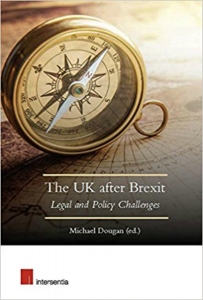Book Review | The UK after Brexit: Legal and Policy Challenges edited by Michael Dougan
In the edited collection The UK after Brexit: Legal and Policy Challenges, Michael Dougan brings together contributors to explore the key challenges facing the UK legal system and broader public policy environment following the UK Brexit vote and resulting de-Europeanisation process. This comprehensive work gives prime insight into the profound restructuring of the UK’s institutional landscape that may be on the horizon, writes Jim McConalogue.
 Picture: freeimage4life/Public Domain
Picture: freeimage4life/Public Domain
The UK after Brexit: Legal and Policy Challenges. Michael Dougan (ed.). Intersentia. 2017.

The UK after Brexit: Legal and Policy Challenges is a multi-authored, collective work by academics offering long-term, Brexit-related guidance that will appeal as much to students and policymakers as to academics. It analyses some of the key challenges facing the UK legal system and, to an extent, the broader public policy environment through the de-Europeanisation and Brexit process. This review focuses on the discussion of the constitutional and political dimensions of policy change, although the book itself also considers the broader Brexit process, including environmental law, financial services, intellectual property, residence rights, trade, foreign investment and international peace and security, among other major issues.
Certainly, the publication date of the volume is important – editor Michael Dougan’s ‘Introduction’ is dated April 2017 – and so cannot be expected to cover either the now-completed first phase of negotiations or the start to the second phase on transition and the future relationship. As it was essentially drafted pre-Withdrawal Bill, the volume is not immersed in party or legislative positions following the 2017 General Election – and yet the medium- to long-term concerns and issues addressed remain significantly valuable to the ongoing negotiations and continued Brexit process.
As Dougan acknowledges from the outset, there are some basic constitutional approaches and legal assumptions which allow the contributors to identify many of the key challenges as well as the parameters that may also limit the room for manoeuvre. For example, how will the difficulties in securing a comprehensive trade agreement, and within a two-year period, as described by Paul Craig in Chapter Fifteen, be dealt with before March 2019? Furthermore, will Jo Hunt’s (Chapter Two) conclusion prevail in that despite the devolved nations having no capacity to offer proper resistance to the resurgence of the government’s unitary state perspective through legal channels, it still remains to be seen how effective their political resistance may be. Nicola Sturgeon’s ongoing opposition to the UK Government’s EU Withdrawal Bill has sought to answer that question.
And in the current negotiation hurdle over an effective settlement on customs arrangements and the Northern Ireland border question, Dougan’s Chapter Three remains relevant and necessary for gaining some foresight. On Northern Ireland, as Dougan identifies, the ongoing obstacle for both the UK and EU is to manage the land border in a form which minimises economic and political disruption on the island of Ireland while safeguarding the interests of both the whole of the EU and the UK in a newly constituted customs territory. Further, it remains a central concern to ensure the durability of the Common Travel Area, allowing people to cross the land border without controls – as does the inherent challenge in recognising the degree of immigration cooperation which will be required between the UK and the Republic.
On the nature of UK constitutional change, Michael Gordon’s chapter on the relationship between parliament and government during the Brexit process, and the attempts to unravel four decades of legal integration while establishing new relations with the rest of the continent, is notable for its depth of observation and balance. As Dougan recognises in the Introduction, de-Europeanisation implies change at a fundamental level in the balance of power between our legal and political actors. Gordon illuminates how new tensions will lead to a new model, not some pre-1972 condition. His sophisticated analysis deals with the referendum as a juxtaposition of direct and representative democratic authority, not least because representative institutions themselves (the elected government through parliament) were the source of the resort to direct decision-making.
And yet while Gordon is critical of the ‘restoration’ view of parliamentary sovereignty, some consideration of its underlying ‘resettlement’ might need to be considered in time, particularly in the light of the broad scope of EU competencies that the current government suggests will (if followed through) be returned to Westminster. Furthermore, how will the differences in views between the Brexit- and Remain-supporting voters be channelled into effective regular constitutional engagements, rather than the delivery of irregular shocks? A great deal of this discussion can be placed in the context of the UK existing within a state of constitutional ‘unsettlement’ (to reference Neil Walker’s term used in earlier research), some of which is Brexit-related, some inevitable given our current constitutional framework. We now appear to be moving to our current state, where the Brexit process may represent a newer form of ‘resettlement’.
Thomas Horsley’s fourth chapter on the UK courts in the Brexit process examines far-reaching changes to the UK courts’ institutional functions and roles post-Brexit within the domestic legal order as a result of the repeal of the European Communities Act 1972 (ECA), albeit partly written ahead of the White Paper on the Repeal Bill and the proceedings on the Bill itself. As with Gordon’s adapted view of ‘constitutional unsettlement’, Horlsey offers a thoughtful, conceptual analysis which helps to understand the Brexit process through ‘triangulated dynamics’. This is useful to the extent that it assumes the process relies on (i) the UK government aspirations and objectives for a new relationship, but also refers to (ii) domestic law being required both legally and practically, and by EU27 agreement, to maintain links with the post-Brexit EU legal order and (iii) the reaction of national courts. The merits of Brexit as a triangulated process, it could be argued, may be limited by the ongoing, politically contested nature of all three variables – and also the extent to which the process rests upon the doctrine of parliamentary sovereignty, which preserves the centrality of parliament itself in political decision-making.
The collection as a whole testifies to the manner in which de-Europeanisation is inevitably going to impact and reshape different parts of the legal system in varying ways. Horsley’s specific examination of what may happen over time suggests that domestic courts, including the Supreme Court, ‘can expect to see a significant reduction of their extraordinary competence to set aside primary UK legislation’, which will ‘profoundly restructure the institutional relationship between the judiciary and legislature established under the ECA’. This may be of interest to broader political or institutional analysts, not least because since 1973, the UK’s governing structures have incorporated EU institutions through a fusion of the executive with EU machinery, the dilution of the domestic legislature and the fusion of the judiciary with the Luxembourg court system, which has significantly impacted upon and unsettled the political strength of parliamentary and broader decision-making powers. Horsley’s account of the profound restructuring that may potentially unfold between the judiciary and legislature in the Brexit process gives primary insight into the institutional landscape to come.
This review gives the views of the author, and not those of Democratic Audit. It was first published on the LSE Review of Books blog.
Jim McConalogue received his PhD from The Open University examining UK parliamentary sovereignty in relation to European Union membership.





 Democratic Audit's core funding is provided by the Joseph Rowntree Charitable Trust. Additional funding is provided by the London School of Economics.
Democratic Audit's core funding is provided by the Joseph Rowntree Charitable Trust. Additional funding is provided by the London School of Economics.